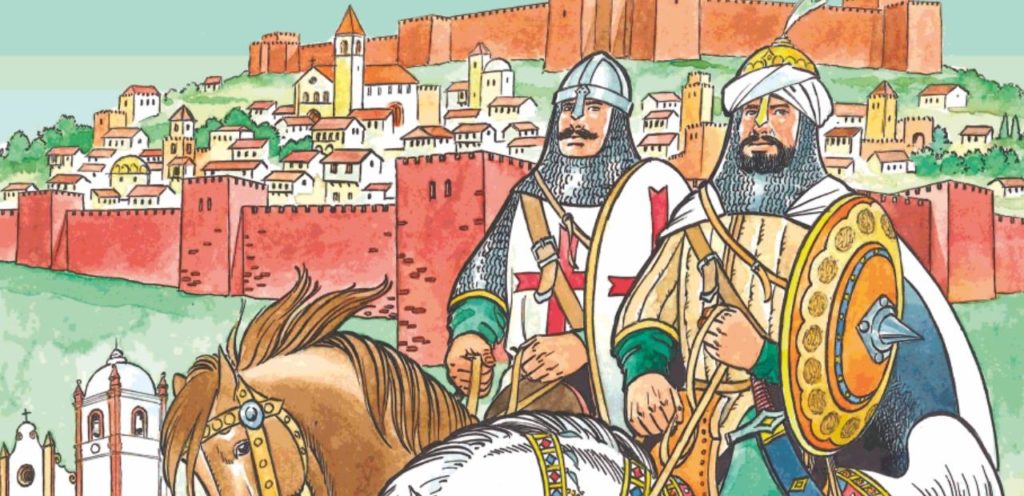 “The History of Silves in Comic Strip” will be officially presented next Saturday, December 10th, at 15 pm, in a ceremony taking place at Paços do Concelho, in Silves. Pedro Mota, president of the Clube Português de Banda Desenhada, the author of the book, José Garcês, renowned illustrator and painter, and also mayor Rosa Palma, will be present.
“The History of Silves in Comic Strip” will be officially presented next Saturday, December 10th, at 15 pm, in a ceremony taking place at Paços do Concelho, in Silves. Pedro Mota, president of the Clube Português de Banda Desenhada, the author of the book, José Garcês, renowned illustrator and painter, and also mayor Rosa Palma, will be present.
This publication tells the story of Silves from its genesis to the present day, with a focus on the modern era, ending with the legend of the almond trees.
Also worth mentioning in this book is the cork industry – due to its importance in the history of Silves – as well as some of the notable figures of the municipality of the XNUMXth and XNUMXth centuries, such as Maria Keil, Francisco Vieira, Gregório Mascarenhas, Bernardo Marques, among others.
According to mayor Rosa Palma, the publication of this work by the municipality is “a very important contribution to the enrichment of the dissemination of the history of the city of Silves and its territory”.
The ceremony will end with a visit to the allusive exhibition, on display at the Municipal Museum of Archeology of Silves.
The launch of this book, commissioned by the Chamber of Silves to José Garcês, "integrates the culture, tourism and education policies pursued by the permanent municipal executive, led by Rosa Palma, aiming at the promotion and dissemination of the history of the city of Silves, namely its cultural heritage, as an asset directly associated with the dissemination of the municipality of Silves, increasing cultural and tourist interest in visitation and consequent local/regional development».
The “History of Silves in Comics” tells the story of a territory with very ancient human occupation and rich in facts and episodes, which dates back to the Iron Age, and where Greeks, Phoenicians, Carthaginians, Romans and Muslims passed through. It shows important figures of local culture and sport, as well as enchants us with the famous “Legend of Amendoeiras em Flor”.
José dos Santos Garcês is an illustrator and painter. He graduated in drawing and graphic arts (1946) from the António Arroio School of Decorative Arts, in Lisbon.
In that year, he began his career as an author of Banda Desenhada (BD) joining the team of the newspaper “O Mosquito”. From 1946 onwards, he collaborated in more than a dozen publications dedicated to children and adolescents, published in Portugal.
He draws for various school publishers, in books on History, Geography, Science, Portuguese and Mathematics, for different levels of education.
He collaborated with the newspaper “O Século”, where he participated with drawings for various competitions and initiatives. Participates in a monograph of the Portuguese Armed Forces, with designs of military uniforms, published by the Ministry of Defense in 1960.
Designs for various entities such as the League for the Protection of Nature, CTT, National Match Society, “Revista de Turismo” and TAP.
During the 80s, he was president of the Clube Português de Banda Desenhada, participating in colloquiums and lectures in schools across the country and teaching courses in his area for students and teachers.
He received the Prize from the National Center for Culture/Ministry of Youth (1988). Guest of Honor at the Lucca Comic Book Festival, Italy (1990), where he presents an exhibition on the History of Portugal. Gold Medal of Merit and Dedication in the area of comics granted by the Municipality of Amadora (1991).
Honored in Viseu, in 2015, by the Viseu Cultural and Artistic Intervention Group (GICAV).
Last March, he was honored by the Clube Português de Banda Desenhada (70 years of career) and in October he received the Dr. Maria Raquel Ribeiro Award, for his active career after 80 years (Portuguese Psychogerentology Association).
He is the author of constructions made of cardboard, including the “Monastery of Batalha”, “Monastery of Jerónimos”, “Torre de Belém” and “Catedral da Guarda”.


















Comments